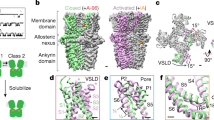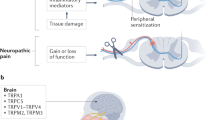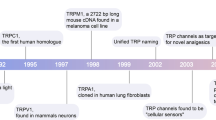Abstract
Some members of the transient receptor potential (TRP) family of cation channels mediate sensory responses to irritant substances. Although it is well known that TRPA1 channels are activated by pungent compounds found in garlic, onion, mustard and cinnamon extracts, activation of TRPV1 by these extracts remains controversial. Here we establish that TRPV1 is activated by pungent extracts from onion and garlic, as well as by allicin, the active compound in these preparations, and participates together with TRPA1 in the pain-related behavior induced by this compound. We found that in TRPV1 these agents act by covalent modification of cysteine residues. In contrast to TRPA1 channels, modification of a single cysteine located in the N-terminal region of TRPV1 was necessary and sufficient for all the effects we observed. Our findings point to a conserved mechanism of activation in TRP channels, which provides new insights into the molecular basis of noxious stimuli detection.
This is a preview of subscription content, access via your institution
Access options
Subscribe to this journal
Receive 12 print issues and online access
$209.00 per year
only $17.42 per issue
Buy this article
- Purchase on Springer Link
- Instant access to full article PDF
Prices may be subject to local taxes which are calculated during checkout








Similar content being viewed by others
References
Clapham, D.E. TRP channels as cellular sensors. Nature 426, 517–524 (2003).
Szallasi, A. & Blumberg, P.M. Vanilloid (capsaicin) receptors and mechanisms. Pharmacol. Rev. 51, 159–212 (1999).
Caterina, M.J. & Julius, D. The vanilloid receptor: a molecular gateway to the pain pathway. Annu. Rev. Neurosci. 24, 487–517 (2001).
Macpherson, L.J. et al. The pungency of garlic: activation of TRPA1 and TRPV1 in response to allicin. Curr. Biol. 15, 929–934 (2005).
Block, E. The chemistry of garlic and onions. Sci. Am. 252, 114–119 (1985).
Block, E. Recent results in the organosulfur and organoselenium chemistry of genus Allium and Brassica plants. Relevance for cancer prevention. Adv. Exp. Med. Biol. 401, 155–169 (1996).
Calvey, E.M., Roach, J.A. & Block, E. Supercritical fluid chromatography of garlic (Allium sativum) extracts with mass spectrometric identification of allicin. J. Chromatogr. Sci. 32, 93–96 (1994).
Calvey, E.M., White, K.D., Matusik, J.E., Sha, D. & Block, E. Allium chemistry: identification of organosulfur compounds in ramp (Allium tricoccum) homogenates. Phytochemistry 49, 359–364 (1998).
Hinman, A., Chuang, H.H., Bautista, D.M. & Julius, D. TRP channel activation by reversible covalent modification. Proc. Natl. Acad. Sci. USA 103, 19564–19568 (2006).
Macpherson, L.J. et al. Noxious compounds activate TRPA1 ion channels through covalent modification of cysteines. Nature 445, 541–545 (2007).
Lishko, P.V., Procko, E., Jin, X., Phelps, C.B. & Gaudet, R. The ankyrin repeats of TRPV1 bind multiple ligands and modulate channel sensitivity. Neuron 54, 905–918 (2007).
Jones, M.G. et al. Biosynthesis of the flavor precursors of onion and garlic. J. Exp. Bot. 55, 1903–1918 (2004).
Caterina, M.J. et al. Impaired nociception and pain sensation in mice lacking the capsaicin receptor. Science 288, 306–313 (2000).
Story, G.M. et al. ANKTM1, a TRP-like channel expressed in nociceptive neurons, is activated by cold temperatures. Cell 112, 819–829 (2003).
Jara, A., Islas, L.D., Garcia-Villegas, R. & Rosenbaum, T. On the mechanism of TBA block of the TRPV1 channel. Biophys J. 92, 3901–3914 (2007).
Nilius, B. et al. Gating of TRP channels: a voltage connection? J. Physiol. (Lond.) 567, 35–44 (2005).
Jordt, S.E. et al. Mustard oils and cannabinoids excite sensory nerve fibres through the TRP channel ANKTM1. Nature 427, 260–265 (2004).
Vyklicky, L., Lyfenko, A., Susankova, K., Teisinger, J. & Vlachova, V. Reducing agent dithiothreitol facilitates activity of the capsaicin receptor VR-1. Neuroscience 111, 435–441 (2002).
Susankova, K., Tousova, K., Vyklicky, L., Teisinger, J. & Vlachova, V. Reducing and oxidizing agents sensitize heat-activated vanilloid receptor (TRPV1) current. Mol. Pharmacol. 70, 383–394 (2006).
Cortright, D.N., Krause, J.E. & Broom, D.C. TRP channels and pain. Biochim. Biophys. Acta 1772, 978–988 (2007).
Venkatachalam, K. & Montell, C. TRP channels. Annu. Rev. Biochem. 76, 387–417 (2007).
Bautista, D.M. et al. Pungent products from garlic activate the sensory ion channel TRPA1. Proc. Natl. Acad. Sci. USA 102, 12248–12252 (2005).
Bautista, D.M. et al. TRPA1 mediates the inflammatory actions of environmental irritants and proalgesic agents. Cell 124, 1269–1282 (2006).
Hess, D.T., Matsumoto, A., Kim, S.O., Marshall, H.E. & Stamler, J.S. Protein S-nitrosylation: purview and parameters. Nat. Rev. Mol. Cell Biol. 6, 150–166 (2005).
Matalon, S. et al. Regulation of ion channel structure and function by reactive oxygen-nitrogen species. Am. J. Physiol. Lung Cell. Mol. Physiol. 285, L1184–L1189 (2003).
Yoshida, T. et al. Nitric oxide activates TRP channels by cysteine S-nitrosylation. Nat. Chem. Biol. 2, 596–607 (2006).
Jin, X., Touhey, J. & Gaudet, R. Structure of the N-terminal ankyrin repeat domain of the TRPV2 ion channel. J. Biol. Chem. 281, 25006–25010 (2006).
Corey, D.P. et al. TRPA1 is a candidate for the mechanosensitive transduction channel of vertebrate hair cells. Nature 432, 723–730 (2004).
Howard, J. & Bechstedt, S. Hypothesis: a helix of ankyrin repeats of the NOMPC-TRP ion channel is the gating spring of mechanoreceptors. Curr. Biol. 14, R224–R226 (2004).
Michaely, P., Tomchick, D.R., Machius, M. & Anderson, R.G. Crystal structure of a 12 ANK repeat stack from human ankyrinR. EMBO J. 21, 6387–6396 (2002).
Macpherson, L.J. et al. An ion channel essential for sensing chemical damage. J. Neurosci. 27, 11412–11415 (2007).
Stein, A.T., Ufret-Vincenty, C.A., Hua, L., Santana, L.F. & Gordon, S.E. Phosphoinositide 3–kinase binds to TRPV1 and mediates NGF-stimulated TRPV1 trafficking to the plasma membrane. J. Gen. Physiol. 128, 509–522 (2006).
Sigworth, F.J. The variance of sodium current fluctuations at the node of Ranvier. J. Physiol. (Lond.) 307, 97–129 (1980).
Rosenbaum, T. & Gordon, S.E. Dissecting intersubunit contacts in cyclic nucleotide-gated ion channels. Neuron 33, 703–713 (2002).
Kwan, K.Y. et al. TRPA1 contributes to cold, mechanical, and chemical nociception, but is not essential for hair-cell transduction. Neuron 50, 277–289 (2006).
Acknowledgements
We thank D. Julius for providing the TRPV1 cDNA and S. Simon and M. Rosenbaum for thoughtful discussion of this manuscript. We also thank L. Ongay, A. Aguilera Jiménez, J. Barbosa, F. Sierra, C. Rivera and H. Malagón for expert technical support and R. Argüello García for his most kind gift of allicin. This work was supported by grants from Dirección General de Asuntos del Personal Académico-Universidad Nacional Autónoma de México (DGAPA-UNAM) IN201705 and IN200308 to T.R. and IN202006–39 to L.D.I. and Consejo Nacional de Ciencia y Tecnología (CONACyT) No. 58038 to T.R., No. 48990/24777 to L.D.I., and No. 43128 to R.G.-V.; and by a grant from the National Eye Institute to S.E.G.
Author information
Authors and Affiliations
Contributions
H.S., I.L. and A.J.O. contributed equally to this work. I.L. and T.R. carried out all site-directed mutagenesis experiments. H.S., I.L., A.J.O. and L.D.I. performed electrophysiological recordings. R.G.V. and T.R. carried out DRG neuron and behavioral experiments. L.D.I. and T.R. analyzed the data and wrote the manuscript. S.E.G. and M.M. discussed the results and commented on the manuscript.
Corresponding author
Supplementary information
Supplementary Text and Figures
Supplementary Figures 1–6 (PDF 814 kb)
Rights and permissions
About this article
Cite this article
Salazar, H., Llorente, I., Jara-Oseguera, A. et al. A single N-terminal cysteine in TRPV1 determines activation by pungent compounds from onion and garlic. Nat Neurosci 11, 255–261 (2008). https://doi.org/10.1038/nn2056
Received:
Accepted:
Published:
Issue Date:
DOI: https://doi.org/10.1038/nn2056
This article is cited by
-
TRP channels: a journey towards a molecular understanding of pain
Nature Reviews Neuroscience (2022)
-
Topical Applications of Thiosulfinate-Enriched Allium sativum Extract Accelerates Acute Cutaneous Wound Healing in Murine Model
Chinese Journal of Integrative Medicine (2020)
-
To flourish or perish: evolutionary TRiPs into the sensory biology of plant-herbivore interactions
Pflügers Archiv - European Journal of Physiology (2019)
-
Expression and Purification of the Pain Receptor TRPV1 for Spectroscopic Analysis
Scientific Reports (2017)
-
4-isopropylcyclohexanol has potential analgesic effects through the inhibition of anoctamin 1, TRPV1 and TRPA1 channel activities
Scientific Reports (2017)



